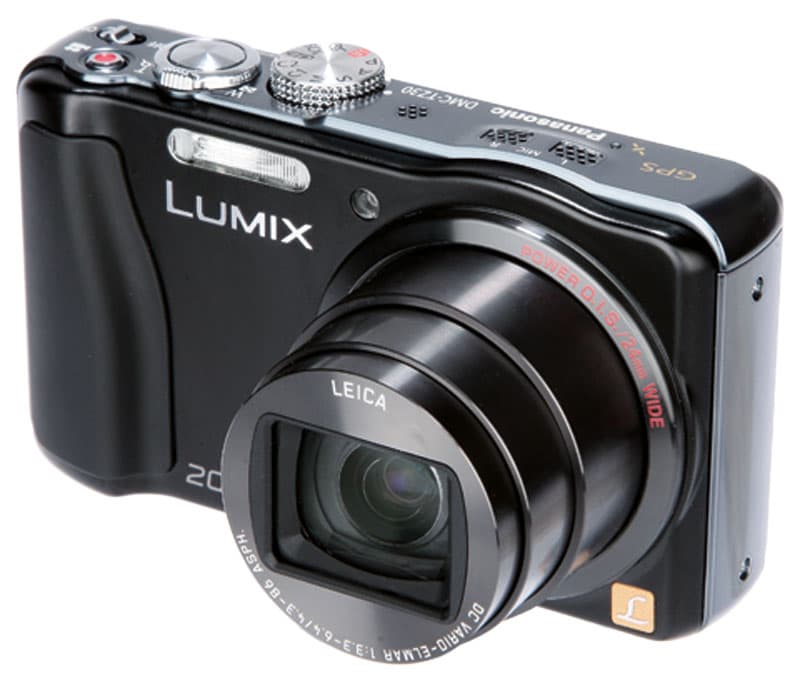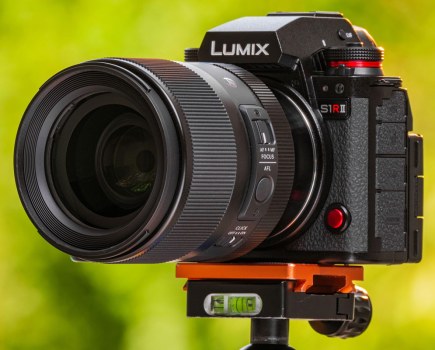Panasonic Lumix DMC-TZ30 at a glance:
- 14.1 million effective pixels
- 1/2.33in (6.16×4.62mm) sensor
- 20x optical zoom (24-480mm equivalent)
- ISO 100-3200 (1600-6400 High Sensitivity mode)
- 5fps with continuous AF
- Street price around £330
Travel cameras are designed to be pocked sized, and to provide the features needed to cover a wide range of situations. Panasonic’s Lumix TZ series is one of the market leaders and the DMC-TZ30 is the latest flagship model. It is an engineering feat to include a 20x optical zoom in a camera of this size, which is the sort of range normally reserved for larger bridge cameras, such as Panasonic’s Lumix DMC-FZ150 with its 24x optical zoom.
Camera designers must walk a fine line between producing models that have good image quality and offering the widest possible focal-length lens. The lens of a bridge camera is larger and packs more glass than a compact camera optic, and should result in sharper results. So can a compact camera such as the TZ30 really do a comparable job?
Features

 Images: The TZ30’s 20x optical zoom enables a tight crop of the statue. Left: 480mm, right: 24mm
Images: The TZ30’s 20x optical zoom enables a tight crop of the statue. Left: 480mm, right: 24mm
Cameras at this level are announced so frequently that there is often little to choose between one model and its replacement. That cannot be said of the TZ30, though, as there are significant improvements in several areas over its TZ20 predecessor.
One of the more eye-catching changes is the new Leica lens. While the 16x zoom in the TZ20 is great for a wide range of uses, the 20x zoom of the TZ30 provides an even greater reach. It is equivalent to a 24-480mm range (4.3-86mm with 5.62x crop factor), and offers a 2x digital zoom, which extends the range to 960mm. Flare is reduced via the use of Panasonic’s Nano Surface Coating technology.
Crucially, the optical image stabilisation (Power OIS) has been improved. Without good stabilisation, handheld shots taken at telephoto focal lengths are mostly unusable, so it will be interesting to see how it performs.
Like the TZ20, the TZ30 has a touchscreen through which the zoom and shutter release can be operated. The display and handling are similar to the company’s Lumix G-series touchscreen models.
Another feature handed down from the G series is ‘light-speed’ focus, which has a claimed focus speed of 0.1sec. This is fast for any camera, let alone a pocket-sized compact. Whether this possible for all conditions is another matter.
The 1/2.33in (6.16×4.62mm) sensor of the TZ30 has the same 14.1-million-pixel output as the TZ20. However, the sensor has been redesigned and is claimed to have a 65% reduction in its signal-to-noise ratio. This type of noise is added by the camera’s electronics and is typically noticeable in shadow areas. Furthermore, the new Venus Engine is claimed to give improved noise reduction. Perhaps it is through these improvements that Panasonic feels confident enough to extend the ISO range by 1EV to a maximum ISO 3200.
Shooting modes include intelligent auto (iA), HDR, panorama shot and 3D. The 3D mode is recorded at the widest focal length and at the most open aperture of f/3.3, and by panning the horizontally.
Marketed as it is for travel, the TZ30’s GPS function has been developed. A disc is included with the camera containing 1:25,000-scale maps of 90 countries. Once loaded to the memory card, a mapping feature can plot the route taken by the photographer, along with place names and landmarks.
Build and handling
The TZ30’s plastic body is virtually identical to that of its predecessor and is solid. There is a silver top panel offset by a main section that is available in black, silver, red or pearl. The TZ30 measures 104.9×58.9×28.2mm, and is just 25mm at its thinnest point.
Touchscreen operation adds another dimension to the camera’s handling. The user can touch anywhere on the back of the screen to focus and then fire the shutter.Those with stubby fingers may struggle a little with the touch menu on the side, but touch shutter is responsive. The screen is a little duller than equivalent units that are not touch sensitive, and requires a good clean to remove finger smudges for clear viewing, especially in bright sunlight.
The camera does not rely solely on the touchscreen, as there are buttons on the body, including a D-pad and quick menu access. One advantage the touchscreen has over using the buttons is the quicker zoom control between the extreme focal-length settings. Having used the camera in various situations, I found that the extra focal length in the TZ30 offers limited benefit over the 16x zoom in the TZ20.
Manual-exposure control is possible, with f/3.3-8 available at 24mm and f/6.4-8 at 480mm. Due to the 5.62x crop factor, there is less control over depth of field with a compact camera such as this. The camera lacks an exposure dial, with aperture and shutter speed instead controlled through
the exposure/map button and then the D-pad, from where exposure compensation can be dialled in.
Image stabilisation is much improved, and even at telephoto focal lengths speeds of 1/15sec are possible for blur-free, handheld results. Crucially, slower shutter speeds allow for lower ISO ratings. This is key for a camera with a compact imaging sensor, where the image quality quickly degrades
as the ISO rating increases.
The GPS maps are particularly fun to use, but the TZ30’s already modest battery life is further compromised when the function is on.
Performance

Image: Panorama shot makes use of the fast burst mode, stitching numerous frames together to create a wide vista
Like the TZ20, the TZ30 reaches 22 on our resolution charts up to ISO 200, as we would expect from a camera of this type that has approximately 14 million pixels. Panasonic’s claims of reduced noise appear to be merited. Although the TZ20 and TZ30 perform similarly up to ISO 400, the TZ30 does better at higher settings. This is because the effects of luminance noise are controlled more effectively in the newer model, with improved image quality at ISO 800 and above. Chroma noise in the form of small yellow blotches is apparent from ISO 800, and in some cases at ISO 200.
Viewing images at 100% shows the quality of detail typical of a camera with this size of sensor. JPEG compression reduces noise, but this results in detail that is smudged and ‘grainy’ at all ISO ratings, and especially so at ISO 800 and above. However, for prints up to 10x8in, the quality of detail is much less noticeable.
Colour modes are limited to standard, vivid, b&w and sepia settings. In standard mode, natural colour rendition is as good as the TZ30’s predecessor. The greens of a landscape are pleasant, while the sky leans towards cyan rather than blue. Those photographers who are fussy about good saturation and the dynamic range of their images would do best to stick to ISO 100 and 200 – any higher and images start to look flat and dull. That said, this is not unusual for a camera at this level.
AF speeds are near instant in high-contrast light, and shutter lag is minimal. In lower-contrast light, the AF assist lamp helps focusing for close-range subjects no end, and a successful focus is achieved after approximately 0.8secs. Offering continuous AF for a 5fps burst is no mean feat, and this worked well when I captured sequences of white-water rafting.
Resolution, Noise & Dynamic Range

These images show 72ppi (100% on a computer screen) sections of images of a resolution chart, captured with the lens set to its 100mm point. We show the section of the resolution chart where the camera starts to fail to reproduce the lines separately. The higher the number visible in these images, the better the camera’s detail resolution is at the specified sensitivity setting.
Images below: Unsurprisingly, the wide-focal-length lens suffers from lens distortions, and even JPEG compression cannot remove chromatic aberrations, as seen in the tree branches. Image detail is satisfactory.



Verdict
If the Panasonic Lumix DMC-TZ30 were scored on features alone, it would get top marks. It is also quick and easy to use, covers an extensive focal range and has a host of neat shooting modes.
Image quality is not quite as crisp as that of the Panasonic Lumix DMC-FZ150, but it is an improvement over the TZ20 at higher ISO settings.
Panasonic has once again improved its solid line-up of TZ travel compacts.






